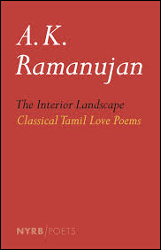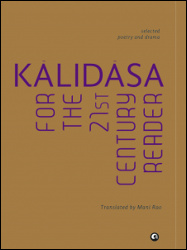|
by Elen Turner
 
A. K. Ramanujan (editor and translator), The Interior Landscape: Classical Tamil Love Poems, New York Review of Books, 2014. 126 pgs. Mani Rao (translator), Kālidāsa for the 21st Century Reader, Aleph Book Company, 2014. 292 pgs. Two recent re-translations and re-publications of classical poetry and drama give Anglophone readers fresh exposure to the classical languages of India: Sanskrit and Tamil. The Interior Landscape is a re-release of a volume that first appeared in 1967; Kālidāsa for the 21st Century is a thoroughly new and innovative translation of Sanskrit classics that, as the title suggests, draws out the relevance of this oeuvre for the contemporary reader. A. K. Ramanujan, in his translator's note to The Interior Landscape, suggests reading the small volume's afterword first. It is a wise suggestion, but one that depends on a reader's purpose for reading this volume of Tamil poetry. If it is to appreciate the cadences of the poems in translation, then diving right in would be appropriate. But if it is to gain an understanding of the context of the poems, how they fit within the classical Tamil literary tradition and what we can hope to learn from them today, a reader should certainly begin at the end. As the final words of the collection read: "These poems are not just the earliest evidence of the Tamil genius. The Tamils, in all their 2,000 years of literary effort, wrote nothing better." Tamil is the only language of contemporary India that is recognisably contiguous with a classical past (Sanskrit, the other classical language discussed here, is arguably not a vernacular language today, and its primary offspring, Hindi, is significantly different). Nevertheless, early classical Tamil is not readily intelligible to a modern Tamil reader/speaker. So in that case, despite Ramanujan's insistence that the purpose of this translation is to enable a non-Tamil reader to "experience" in English something of what a native experiences when reading classical Tamil poems, the volume could be equally valuable to bilingual English-Tamil readers who are not sufficiently versed in the classical form of their language. The form of the poems is immediately striking, with irregular patterns and word placement suggesting irregular metre and structure. As Ramanujan states, his intention is to capture the structure of the poems, so he forwent a line-by-line, literal translation. The politics of translation being as it is, this approach is not likely to satisfy all readers. However, it does reflect what appears to be the dominant emphasis of recent translations of the classics: to make them accessible and appealing to contemporary readers, some of whom may be put off reading previous translations of these gems because of what is perceived to be impenetrable language. This trend is even more explicit in Mani Rao's translations of select works of Kālidāsa's. As she states (revealing her intended audience to be Indian and educated): "Today, if most people know the storylines of Kālidāsa's famous works Śākuntalam and Meghadútam, not as many have actually read them, even in translation. This is unsurprising, for the conventions of ancient Indian poetics are far removed from our present context." Rao does, then, attempt to bridge this gap, allowing present-day readers a way into the realm of ancient India by using language that contemporary actors could speak comfortably on stage (in the longest piece in the collection, the play Abhijñāna Śākuntalam, or Śākuntalā's Souvenir). But who was Kālidāsa? Who he was, where and when he lived or even whether Kālidāsa was a real or a pen name is not known. In this regard, he could be considered akin to Homer. His literature is widely regarded as valuable and civilisation-shaping, but it ultimately does not matter who he was as a person: the author really is dead. Kālidāsa, like Homer, is a litterateur who has been produced by his society (and later societies) as much as he was a writer who produced artefacts within it. Rao upholds such a suggestion by pointing out that Kālidāsa's work—particularly Śākuntalā's Souvenir—has been interpreted and reinterpreted at different points in history according to the needs and mores of the times. For instance, in the late eighteenth century, when members of the East India Company were looking to literature to help them understand Indian culture, this play was upheld as a symbol of the civilisation's glorious past. Rao notes that more recent anthologies of world literature that include Kālidāsa tend to emphasise the poetics, his literary craft. Going further against the grain, Rao includes in this collection Rtusamhāram (A Collection of Seasons), a short collection of poems that tend to be Kālidāsa's least admired works, often taken to be juvenilia, or even composed by somebody else entirely. The Sanskrit originals apparently lack the complexity and profound aesthetic delight characteristic of Kālidāsa, but Rao states that they become "delectable" in English as "minimalistic, carefully laid-out impressionistic vignettes." And this appears to sum up what these two newly published translations from Tamil and Sanskrit are trying to achieve. By 2015, interpretation of the classics is certainly not complete. There are rich possibilities in considering how to present them to audiences that are not only new, but truly global and multicultural. |